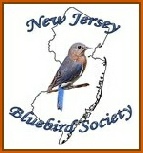Design & Webmaster: Gary Pilling, Design Program: Serif WebPlus x8, Host: iPage


HOUSE WREN PROBLEMS?
House wrens are native species protected by the Migratory Bird Treaty Act but happen to be major nest competitors of bluebirds and other cavity nesting birds. In New Jersey, house wrens are extremely common and are one of the primary species that have a negative impact on our breeding bluebirds. Besides competing for a nest box, house wrens destroy the eggs on any species nesting within their territory. Nothing is more discouraging that finding bluebird eggs, with small holes pecked in them, laying on the ground in front of the box and the box filled with twigs. The impacts can be significant, especially when other factors such as inclement weather have major impacts on our bluebird population. Colder than normal weather in the over wintering grounds suppresses reproduction of bluebirds in the spring. This delay erases the 2-3 week head start the bluebirds usually have on other species, resulting in more direct competition for the nesting boxes.
The house wren tends to nest near the edges of deciduous forests, farm yards, brushy edges, riparian habitats, city parks and residential areas with trees. Try to locate your boxers away from wren habitat and avoid the wrens tenacity. If wrens become a problem try:
1) Relocate your boxes 100’ from shrubby areas. Wrens do not like to fly across open areas that offer no cover for safety. There is evidence that house wrens are moving progressively greater distances from their preferred habitat in order to nest, so 100’ may not be enough.
The male wren fills as many boxes in his territory with twigs to prevent other species from nesting. These are called dummy nests and it is legal to remove them. Only one box will be used by the female wren to nest and lay eggs in. Leave this nest alone. The Bluebird Restoration Association of Wisconsin (Reprinted Bluebird, Vol. 37 No.1, p.17) has had some success by following this practice for dummy nests:
2) Week one - remove the twigs
Week two - remove the twigs and wire the door “wide” open
Week three - remove the wire, making the box available to nest in again
BRAW’s results are promising. For the 76 monitors who followed this procedure, their boxes fledged 0.16 wrens/box compared to the remaining statewide boxes that averaged 0.53 wrens fledged /box (more than 3 times the number of wrens fledged). That effectively left hundreds of boxes available for bluebirds and other cavity nesting songbirds to nest in. (BRAW has over 9,000 boxes in their program)
Dealing effectively with nest competitors helps increase the numbers of bluebirds fledged.
(v.1/22/15)
House Wren - problem